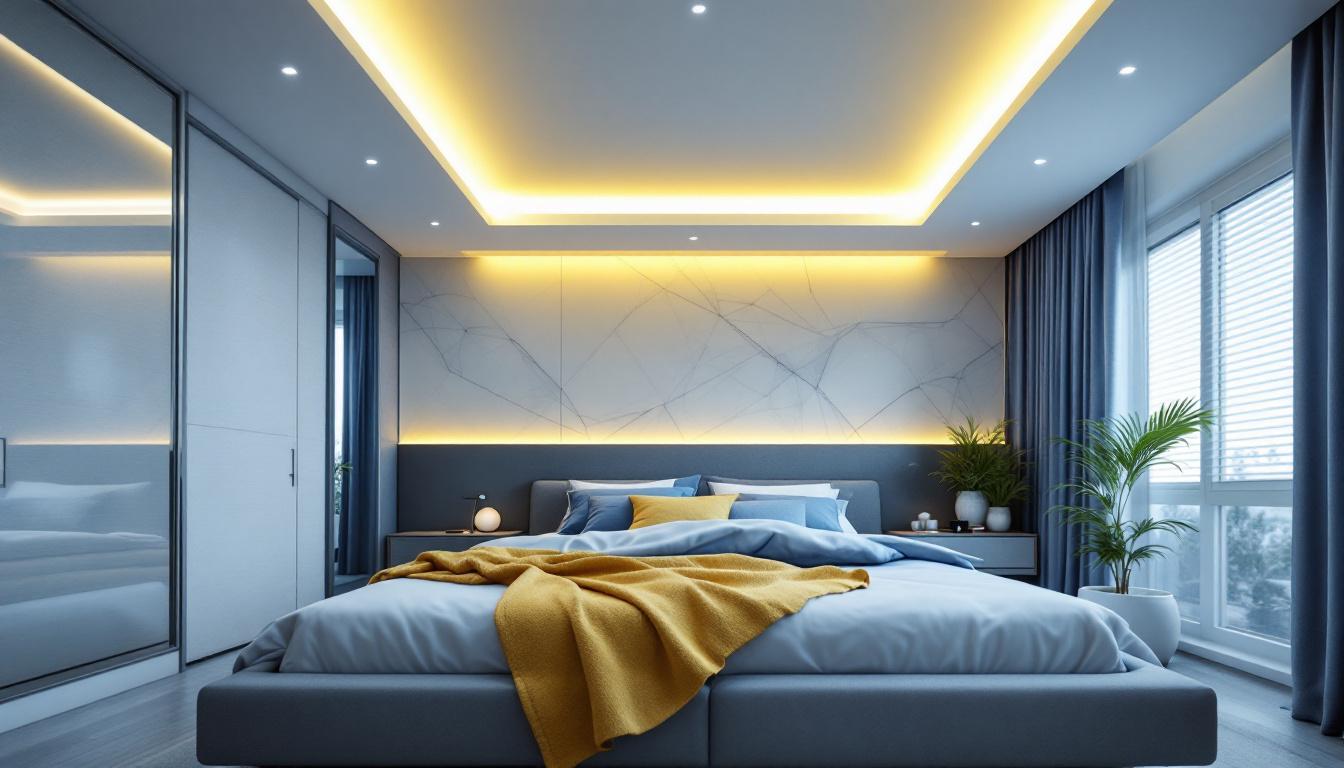
Suspended ceilings, also known as drop ceilings, are a popular choice in residential and commercial spaces due to their aesthetic appeal and functional benefits. They provide an opportunity to conceal electrical wiring, ductwork, and plumbing, creating a clean and polished look in any room. For lighting contractors, understanding the intricacies of suspended ceilings is essential, especially when it comes to bedroom installations.
Bedrooms often require a specific ambiance, and the choice of lighting can significantly impact the overall atmosphere. A well-designed suspended ceiling can enhance this ambiance, but it also presents unique challenges that lighting contractors must navigate. From selecting the right fixtures to ensuring proper installation, there are several factors to consider to avoid common pitfalls.
One of the primary advantages of suspended ceilings is their versatility. They can accommodate various lighting types, including recessed lights, pendant fixtures, and track lighting. This flexibility allows contractors to create customized lighting solutions that meet the specific needs of their clients.
Moreover, suspended ceilings can improve acoustic performance, which is particularly beneficial in a bedroom setting. By absorbing sound, these ceilings can help create a peaceful environment, promoting better sleep and relaxation. Lighting contractors should consider this aspect when designing lighting layouts, ensuring that the chosen fixtures complement the ceiling’s sound-dampening properties.
In addition to their aesthetic and acoustic benefits, suspended ceilings also offer practical advantages in terms of maintenance and accessibility. The modular nature of these ceilings allows for easy access to the space above, making it simpler to address any issues related to wiring or plumbing without extensive renovations. This ease of access can be particularly valuable in bedrooms where homeowners may want to make adjustments or upgrades over time. Furthermore, suspended ceilings can be designed with integrated lighting solutions that not only enhance the room’s functionality but also contribute to energy efficiency, as LED fixtures can be seamlessly installed to provide bright, focused light while minimizing energy consumption.
Another noteworthy aspect of suspended ceilings is their ability to incorporate various design elements that can elevate the overall aesthetic of a bedroom. For instance, contractors can play with different textures, colors, and materials to create a unique ceiling design that complements the room’s decor. Whether opting for a sleek, modern look with smooth panels or a more traditional approach with decorative tiles, the design possibilities are virtually endless. This creative freedom allows lighting contractors to work closely with homeowners to achieve a cohesive look that reflects their personal style while ensuring that the lighting remains functional and effective.
While suspended ceilings offer numerous benefits, they also come with their own set of challenges. Lighting contractors must be aware of these potential issues to deliver successful installations and maintain client satisfaction.
One of the primary concerns with suspended ceilings is their weight capacity. Each ceiling tile and grid system has a specific load-bearing limit, which can restrict the types of lighting fixtures that can be installed. Contractors must assess the structural integrity of the ceiling before proceeding with any installation.
When selecting lighting fixtures, it is crucial to choose options that are lightweight and suitable for the suspended ceiling system. Additionally, contractors should consider the distribution of weight across the grid to prevent sagging or damage over time. Proper planning and consultation with manufacturers can help mitigate these issues. It is also advisable for contractors to stay updated on advancements in materials and technologies that can enhance the performance of suspended ceilings, such as lightweight composite materials that can support a wider range of fixtures without compromising structural integrity.
Electrical installation in suspended ceilings can be more complex than in traditional ceilings. The presence of grid systems and ceiling tiles may complicate the routing of electrical wiring. Lighting contractors must ensure that all wiring is properly secured and compliant with local codes to avoid safety hazards.
Furthermore, the integration of smart lighting systems can add another layer of complexity. Contractors should be well-versed in the latest technology and ensure that all components are compatible with the suspended ceiling design. This knowledge will not only enhance the functionality of the lighting but also provide clients with a seamless user experience. Moreover, contractors should consider the future scalability of the lighting system; as businesses evolve, the need for adaptable lighting solutions may arise. This foresight can lead to recommendations for modular systems that allow for easy upgrades or changes without extensive renovations, thereby saving time and resources in the long run.
The design phase is critical in any lighting project, particularly when working with suspended ceilings in bedrooms. A well-thought-out design can enhance the aesthetic appeal of the space while addressing practical concerns. Proper lighting can transform a bedroom from a simple resting place into a serene sanctuary, tailored to the needs and preferences of its inhabitants. It is essential to consider how the lighting will interact with other design elements, such as color palettes, furniture styles, and window placements, to create a cohesive and harmonious environment.
When selecting lighting fixtures for a suspended ceiling bedroom, it is essential to consider the overall design theme and functionality. Recessed lighting is a popular choice, as it provides a clean look and can be strategically placed to highlight specific areas of the room. However, contractors should also explore other options, such as pendant lights or wall sconces, to add visual interest and depth. For instance, a stylish pendant light can serve as a focal point above a bed or seating area, while wall sconces can create a warm glow on either side of the bed, enhancing the room’s intimacy.
Additionally, the color temperature of the lighting is crucial in creating the desired ambiance. Warm white lights can evoke a cozy and inviting atmosphere, while cooler tones may contribute to a more modern and energetic feel. Contractors should work closely with clients to determine their preferences and tailor the lighting design accordingly. It may also be beneficial to incorporate dimmable fixtures, allowing occupants to adjust the brightness based on the time of day or specific activities, such as reading or relaxing. This flexibility can significantly enhance the overall experience of the space.
In a bedroom setting, layering light is essential for creating a versatile and functional space. This involves combining different types of lighting—ambient, task, and accent—to achieve a balanced and inviting environment. Ambient lighting provides overall illumination, while task lighting focuses on specific areas, such as bedside reading lamps or desk lights. The careful placement of these elements can help to delineate different zones within the bedroom, making it easier to navigate and use the space effectively.
Accent lighting can be used to highlight architectural features or artwork, adding depth and character to the room. By incorporating multiple layers of light, contractors can ensure that the bedroom is not only aesthetically pleasing but also practical for various activities. For example, a well-placed accent light can draw attention to a beautiful piece of art or a unique architectural detail, while soft ambient lighting creates a relaxing atmosphere for winding down at the end of the day. Furthermore, integrating smart lighting systems can offer added convenience, allowing homeowners to control their lighting remotely or set schedules that align with their daily routines, thereby enhancing both functionality and comfort in the bedroom.
Proper installation is key to the success of any lighting project, particularly in suspended ceiling applications. Following best practices can help contractors avoid common issues and ensure a smooth installation process.
Before beginning any installation, thorough planning is essential. Contractors should conduct a site assessment to evaluate the existing conditions of the suspended ceiling and identify any potential challenges. This includes checking for adequate clearance, assessing the weight capacity, and determining the best locations for lighting fixtures.
Additionally, creating a detailed lighting plan can help visualize the final outcome and ensure that all elements are accounted for. This plan should include the type and placement of fixtures, as well as the routing of electrical wiring. Collaborating with other trades, such as HVAC or plumbing, can also help streamline the installation process and prevent conflicts.
Safety should always be a top priority during installation. Contractors must adhere to local building codes and regulations to ensure that all electrical work is performed safely and correctly. This includes using appropriate materials, securing all wiring, and ensuring that fixtures are properly mounted.
Moreover, it is essential to educate clients about the importance of safety in their lighting systems. Providing guidance on maintenance and usage can help prevent issues down the line and ensure that the lighting remains functional and safe.
Once the installation is complete, there are several post-installation considerations that lighting contractors should address to ensure long-term success and client satisfaction.
Educating clients about their new lighting system is crucial for ensuring they understand how to use and maintain it effectively. Contractors should provide clear instructions on operating any smart features, changing bulbs, and performing routine maintenance. This knowledge empowers clients to take ownership of their lighting and enhances their overall experience.
Additionally, contractors should encourage clients to provide feedback on the lighting performance. This information can be invaluable for future projects and can help contractors refine their approach to lighting design and installation.
Offering ongoing support and maintenance services can set contractors apart in a competitive market. Regular check-ins with clients can help identify any issues early on and ensure that the lighting system continues to function optimally. This proactive approach not only fosters positive client relationships but also enhances the contractor’s reputation for quality service.
Furthermore, contractors should stay informed about advancements in lighting technology and design trends. Continuous education and adaptation to new developments can help contractors provide innovative solutions that meet evolving client needs.
Suspended ceilings present unique opportunities and challenges for lighting contractors, particularly in bedroom settings. By understanding the intricacies of suspended ceilings, addressing common challenges, and implementing effective design and installation practices, contractors can create stunning and functional lighting solutions that enhance the overall ambiance of the space.
Through careful planning, adherence to safety standards, and ongoing client education, lighting contractors can avoid potential issues and ensure long-term satisfaction. As the demand for innovative lighting solutions continues to grow, staying informed and adaptable will be key to success in this dynamic industry.
Ready to elevate your suspended ceiling projects with the finest lighting solutions? Look no further than LumenWholesale, where we provide contractors with high-quality, spec-grade lighting products at unbeatable wholesale prices. Our extensive selection not only meets but exceeds industry standards, ensuring your installations shine with reliability and performance. Say goodbye to inflated markups and hello to hassle-free bulk buying with free shipping. Don’t compromise on quality or value—discover the best in wholesale lighting and make your next bedroom lighting project a resounding success with LumenWholesale.

Explore the transformative impact of fluorescent tubes on modern lighting design and installation.

Discover the essential checklist for lighting contractors when installing LED hanging lights.

Discover the transformative power of LED garage strip lights for lighting contractors.

Discover how flood solar lights can maximize efficiency with expert tips. Learn key benefits, optimization strategies, and boost your outdoor lighting today!.